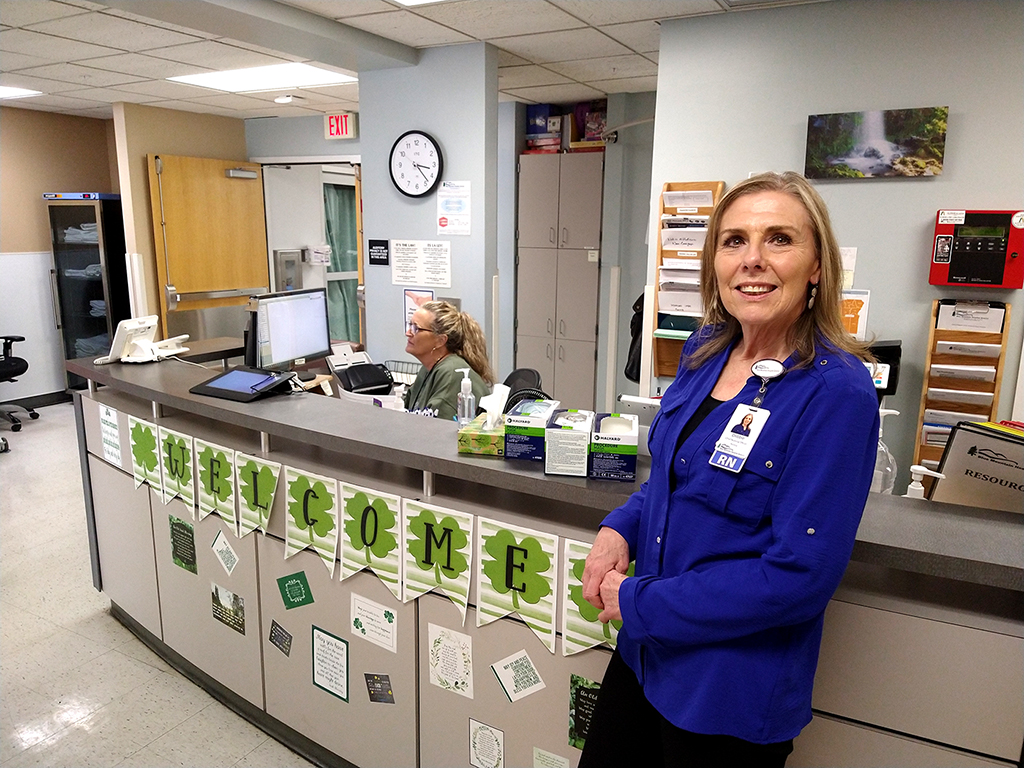Nurturing local talent: Blue Mountain Hospital hopes to fill openings with in-house nursing education program
Published 7:00 am Wednesday, April 2, 2025

- Debbie Morris, chief nursing officer for Blue Mountain Hospital in John Day, stands at a nursing station in the hospital on March 13, 2025, while patient access registrar Cherri Hansen works the desk. To address a chronic nursing shortage, Morris has worked out partnerships with two universities to offer distance-learning education programs at the hospital. (Bennett Hall/Blue Mountain Eagle)
JOHN DAY — When you can’t import what you need, sometimes you just have to produce it yourself.
That’s the approach Blue Mountain Hospital is taking to address its nursing shortage. The John Day hospital is teaming up with Joyce University of Nursing and Health Sciences to start a distance education program that will enable local residents to pursue a nursing degree at home.
“We’re going to grow our own nurses here,” said Debbie Morris, the hospital’s chief nursing officer. “We’re very excited about that.”
Trending
It’s a goal Morris has been pursuing for years.
Faced with a chronic shortage of nurses and the enormous difficulty of recruiting medical professionals to come to a remote rural community, Morris has long believed the solution was to develop a pipeline for local talent.
The problem was the nearest accredited nursing school was a program Oregon Health & Science University ran on the campus of Eastern Oregon University in La Grande — a 125-mile drive from John Day.
“Our community doesn’t have access to higher education,” Morris said. “Our people here are invested in the community, but our experience is if they move away to pursue their education, they don’t come back.”
Nursing shortage or ‘leaky bucket’?
Statistically speaking, Oregon does not have a nursing shortage.
The Oregon Center for Nursing, a nonprofit organization that supports and advocates for the profession, reported to the Legislature in December that the state has around 73,000 licensed nurses, a record number, with more than 54,000 of them practicing as of 2022.
Trending
And more nurses continue to enter the workforce: for every new Oregon nursing graduate, four nurses licensed in other states move here, the center found. But they don’t always stay: with a 30% turnover rate, “Oregon’s nursing workforce operates like a ‘leaky bucket,’”according to the report.
The center also found the state’s nursing workforce is unequally distributed, with employers facing “chronic vacancies” in rural areas.
Those vacancies are glaringly obvious in Eastern Oregon, where an Oregon Employment Department survey found the occupation with the most vacancies in 2024 was registered nurse, with 137 job openings going unfilled across the region — despite offering an average wage of $51 an hour. (Nursing assistant and personal care aide were the No. 3 and 4 hardest-to-fill positions in Eastern Oregon last year, the agency reported.)
Finding a partner
The answer to Blue Mountain Hospital’s recruiting challenges, Morris was convinced, was to find a way to offer nursing education closer to home, so students wouldn’t have to relocate to get their degree. But to make that happen, she needed to find an academic institution that was willing — and licensed by the state — to provide instruction in John Day.
She came close to realizing that dream once, reaching a tentative deal with Oregon Health & Science University to offer a distance learning program at the hospital, but those plans fell through.
“We had planned to start in 2021, but then COVID hit,” Morris said.
Morris decided to retire at that point, as did the OHSU associate dean she had been working with. But then Morris came back to work at Blue Mountain Hospital in 2023, and she picked up where she had left off. This time, however, things didn’t go as smoothly.
Frustrated with the slow progress of discussions, Morris reached out to the Oregon Board of Nursing, which recommended Joyce University in Draper, Utah, just outside Salt Lake City.
It turned out to be just what Morris had been looking for.
Joyce offers a 20-month nursing education program that culminates in an associate’s degree, which is enough to get started in the profession. There are no prerequisites — all of those courses are built into the curriculum.
Students will need to travel to the Joyce campus in Utah four times during their training, for four days at a time, to work in the school’s high-tech simulation lab and get intensive clinical training.
But other than that, students will be able to pursue their nursing education close to home. The required clinical rotations — where nurses-in-training shadow experienced providers in real health care settings — will take place at Blue Mountain Hospital District facilities in Grant County and at Harney District Hospital in Burns, which is partnering with Blue Mountain and Joyce. While those rotations will require some travel, the 70-mile drive is much more manageable than the trek to La Grande.
To help keep students on track with their lessons, Joyce University plans to hire a staff nurse at Blue Mountain Hospital to serve as clinical instructor for the program.
The university plans to begin classes for its first cohort at Blue Mountain Hospital in the fall, Morris said, and people are already clamoring to sign up.
“We haven’t even advertised this and we already have eight people who are interested,” Morris said.
Cost-benefit analysis
The Joyce program is not cheap — the price tag is $56,000, according to Morris — but financial aid is available through the school, and Blue Mountain Hospital District employees who enroll are eligible for partial tuition reimbursement from the district.
Moreover, the earning potential for newly minted nurses is substantial. Starting pay for a nurse with an associate’s degree at Blue Mountain Hospital is just under $36 an hour, according to Holly Thompson with the human resources department. After about six months of on-the-job training, the rate typically goes up to a little over $38 an hour, after the nurse achieves an initial competency endorsement.
“As soon as you make competency,” Thompson said, “you’re almost making $80,000 a year.”
Pay rates rise even more for nurses who earn specialty certifications and additional competencies. And they go higher still for nurses who earn a bachelor’s degree.
To that end, Blue Mountain Hospital is in the final stages of discussions with Western Governors University in Millcreek, Utah — another Salt Lake suburb — about hosting a four-year distance-learning program in John Day.
At the March 26 meeting of the Blue Mountain Hospital board, Morris announced the Oregon Board of Nursing had recently approved the university’s request to move ahead with the plan.
Keeping it local
Ultimately, Morris expects the in-house nursing education program to save the hospital money. That’s because positions that can’t be filled with direct hires wind up being filled with “travelers” — nurses brought in on short-term employment agency contracts from outside the area. The contracts typically run for 13 weeks, much of which is taken up with training the new arrivals in Blue Mountain Hospital procedures.
“We have to pay the agency (as well as the nurse),” Morris said. “And it’s a revolving door. … I just don’t believe it’s fair to bring in people from outside the area and give them high-paying jobs when people in our community could take those jobs.”
Blue Mountain Hospital’s interim CEO, Margie Molitor, said she’s “extremely excited” about the partnership with Joyce University to train nursing students locally.
“We need to grow our own,” Molitor said. “It’s a difficult place to recruit to, so if we can grow our own people, it helps us be much more successful.”









